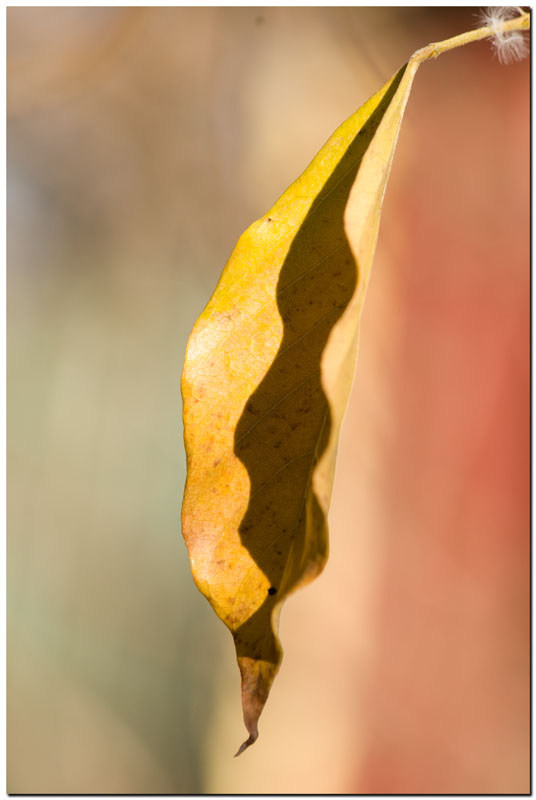Many of you that have been participating in our weekly assignments have probably come to recognize that there is often a certain "flow" to the assignments, where one assignment will provide a natural lead-in to a follow-on assignment. Follow-on assignments are often "suggested" based on what I'm seeing in the current assignment. As I review the images, I'm looking for weaknesses so that I can help you improve in future assignments. Because of this, you might see certain themes repeated over time, maybe from a slightly different perspective.
This week's assignment is "Distraction Free." This assignment is similar to our very first "Isolation" assignment; however it tackles the problem from a different perspective. The guidelines for the "Isolation" assignment were to "use a photographic technique (limited depth of field/selective focus or selective lighting) to isolate your subject within the composition." We tackled this a little bit differently in the "Essence" assignment, where the guidelines were to "identify a 'key characteristic' of a subject, and isolate your composition to this 'key characteristic' to convey a sense of the subject." Both of these assignments attempted to guide you towards the idea of simplicity and clarity in your images, and many of you succeeded. However, over time I have seen more "distractions" creep back into your images, so it is time to emphasize this area of composition from a little bit different perspective.
I can summarize the most common "distractions" as 1) items that don't belong in a composition and steal the attention away from the primary subject 2) partially out-of-focus areas in an image that are disconcerting to the eye (and mind) and distract us from the primary subject, and 3) blown highlights or bright colors that draw our attention away from the primary subject (our eyes are usually drawn to the brightest parts of a scene).
We have several tools and techniques available to help us remove distractions from an image. The first is framing and cropping. You should position yourself relative to your subject and background to attempt to remove distracting elements from the composition. Try to include just enough background to provide context without distracting from the primary subject.
Rick used framing effectively in his Yellow Aspen Leaves image to eliminate distracting background elements. Because he was close to his subject, depth of field was limited and the background was rendered as a pleasing out-of-focus blur.

Yellow Aspen Leaves
Longer focal length lenses are often useful for isolating the subject and removing distracting background elements from the frame. The longer focal length also helps since depth of field is reduced, and you can often use a wide aperture to throw the background completely out of focus, as seen in the puffin image below.
Rod used this technique very effectively in the "isolation" assignment for his
Last Wisteria Leaf image.

Last Wisteria Leaf
Cropping is another powerful tool for removing distracting elements from an image. I'll use an example of Rick's from the "Curves" assignment:

Distracting?

Distraction Free
Blown highlights (one of the most common distractions) can often result when the background is brighter than the primary subject. You can control blown highlights by repositioning or reframing the scene, or by lowering your "ambient" exposure to prevent blowing out the highlights and using fill flash to properly expose the foreground subject. Because of the difference in brightness between the shade and sun, a "normal" exposure for the image below would have resulted in the garden in the background being completely washed out, and the interior of the bungalow being too dark. I lowered my exposure (you can use negative exposure compensation) to keep the garden from being washed out, and used fill flash to light the interior of the bungalow.
Naomi very effectively used framing and cropping and controlled the light in her
Bronze Beauty image to remove all distracting elements from the background.

Bronze Beauty
The assignment for the week of 24 - 30 November 2008 is "Distraction Free." It doesn't really matter what the primary subject is; however, you should concentrate on 1) eliminating items that don't belong in your composition and steal the attention away from the primary subject 2) eliminating partially out-of-focus areas in your image that are disconcerting to the eye (and mind) and distract us from the primary subject, and 3) eliminating blown highlights or bright colors that draw our attention away from the primary subject. Use positioning, framing and cropping to remove distracting elements, and experiment with longer focal length lenses and wide apertures to isolate your subject and completely blur the background. Control the lighting to eliminate blown highlights.
Please upload your images to the "Distraction Free" album by midnight Mountain Time (GMT -07:00) on Sunday, 30 November 2008. Have fun. Let's see some distraction-free images with simplicity and clarity!
Keith